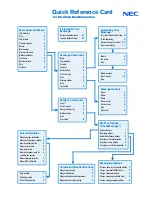
English
28
WILO SE 03/2011
• Observe the dimensions according to the installation plan (Fig. 2).
• According to EN 12056-4, installation rooms for lifting units must be of sufficient size so
that the unit is freely accessible for operating and maintenance work.
• There must be a sufficient working space of at least 60 cm in width and height available
next to and above all parts to be operated and subjected to maintenance.
• The installation room must be frost-proof, ventilated and well-lit.
• The installation surface must be firm (suitable for accommodating dowels), horizontal and
flat.
• The course of any existing or still-to-be installed inlet, pressure and ventilation lines is to
be checked with regard to connection options to the unit.
• Select an installation location suitable for the size of the unit and accessibility of the con-
nections.
• Dimensions of the switchgear (H x W x D): 320 mm x 300 mm x 120 mm
• Install the switchgear and breakdown barrier at a dry and frost-proof location.
• The site must also be protected from direct sunlight.
• Observe the accessories and catalogue specifications for outdoor installations.
• Observe the installation and operating instructions for the accessories!
7.2 Installation
Place the unit on a flat solid floor and align.
According to EN 12056-4, sewage lifting units must be installed in such a manner that they
cannot twist and turn.
Units which threaten to float must be installed so that they are anti-buoyant.
7.3 Connection of the piping
All piping must be installed without tension in a noise-insulated and flexible manner. The
unit must not be subjected to any pipeline forces or torques. The pipes (including valves)
are to be fastened and supported in such a manner that neither tensile nor compressive
forces are applied to the unit.
All line connections must be established with care. Carefully tighten any connections with
hose clamps
(tightening torque of 5 Nm).
Do not reduce the pipe diameter in the direction of flow.
According to EN 12056-4, a gate valve is always required in the inlet pipe in front of the
tank and behind the non-return valve. (Fig. 9).
7.3.1 Discharge piping
CAUTION! Risk of property damage!
Occurring pressure surges (e.g. when closing the non-return valve) can be several
times more than the pump pressure, depending on the operating conditions (to avoid
this, see also 8.2.3 Setting the pump run follow-up time).
• The longitudinal force-fitted connection elements of the piping should therefore be
observed in addition to the corresponding pressure resistance.
• The discharge piping, including all installation parts, must reliably withstand the oper-
ating pressures which occur.
To protect against any backflow out of the main public sewer, the pressure pipeline is to
be designed as a “pipe loop”, the bottom edge of which must lie at the highest point above
the locally defined backflow level (usually at street level) (see also Fig.9).
Fig. 3: Buoyancy safeguard
Fix the unit to the floor with the enclosed fixation material
(Fig. 3).
• Mark the position of the drilled holes on the floor for fas-
tening in the slots on the side of the tank
• Drill holes in the floor.
• Install the supplied threaded rods according to the instal-
lation drawing and the supplied instruction manual for the
mortar cartridges
• Fasten the tank to the floor so that it is anti-buoyant after
the curing of the mortar cartridges
Содержание DrainLift XL
Страница 2: ...Fig 10...
Страница 3: ...Fig 11...











































